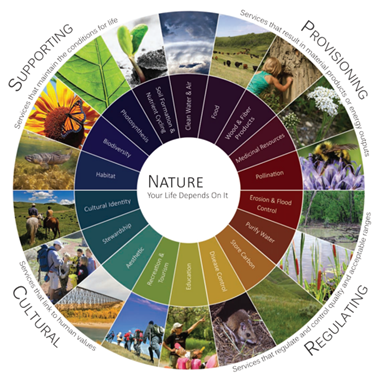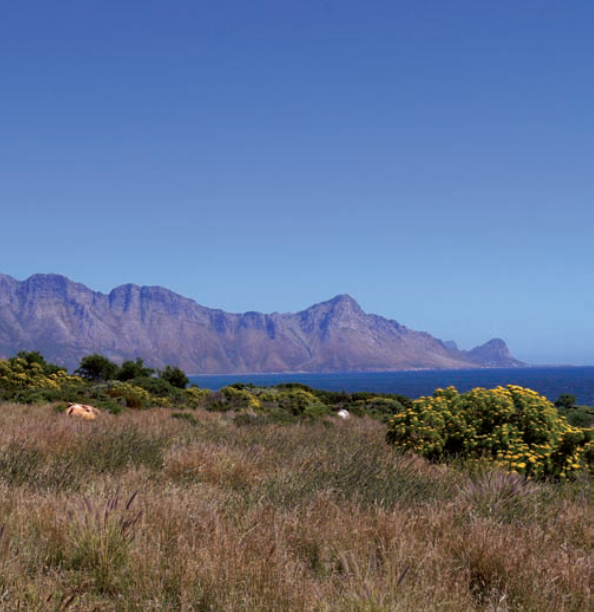What is biodiversity and ecosystem services?
Biological diversity underpins ecosystem functioning and the provision of ecosystem services essential for human well-being. Keeping ecosystems resilient and safeguarding the planet’s biodiversity is fundamental for addressing global societal challenges, contributing towards achieving multiple international targets and simultaneously ensuring the delivery of ecosystem services that are crucial to human dignity and wellbeing.
The Millennium Ecosystem Assessment defined ecosystem services (ES) as "the benefits people obtain from ecosystems". These services are divided into four categories - supporting, provisioning, regulating and cultural - where the so-called supporting services are regarded as the basis for the services of the other three categories (see Figure 1).
A provisioning service is any type of benefit to people that can be extracted from nature. Along with food, other types of provisioning services include drinking water, timber, wood fuel or medicinal benefits. In DRR terms, ecosystems support livelihoods for reducing vulnerability as supporting services.

Figure 1. Ecosystem services classification. ©Helen Schuler.
The regulating services are the basic services provided by ecosystems that that make life possible for people through key processes that make ecosystems sustainable, functional, and resilient to change. Ecosystems act as natural buffers to support flood control and protection; carbon storage and climate regulation are examples of this type of services as well.
But nature can also offer non-material benefits contributing to human well-being through spiritual enrichment, cognitive development, reflection, recreation, and aesthetic experience as cultural services. However, the most fundamental processes that ensures life on Earth, like soil formation and water cycle are provided by the supporting services. Without these, provisioning, regulating, and cultural services wouldn't exist.
The ES concept puts human needs and preferences in the centre of the ecological universe and measures the health of ecosystems based on their ability to provide humans with benefits (Katz-Gerro and Orenstein, 2015).
Biodiversity has a direct impact on the livelihoods and income for billions of people. Over 4.3 billion people, more than half the world’s population, depend on biodiversity for their livelihoods (including forestry, agriculture, and fisheries) and nearly 40% of the world's economy is derived from the direct use of biodiversity.
World Heritage All inherited assets which people value for reasons beyond mere utility. Heritage is a broad concept and includes shared legacies from the natural environment, the creations of humans and the creations and interactions between humans and nature. It encompasses built, terrestrial, freshwater and marine environments, landscapes and seascapes, biodiversity, geodiversity, collections, cultural practices, knowledge, living experiences, etc. site is unique and so too is the range of ecosystem services and benefits it delivers to people at different scales. Although some sites are recognised specifically for their biodiversity values, there are significant opportunities for reinforcing biodiversity conservation and sustainable use of biodiversity in all World Heritage All inherited assets which people value for reasons beyond mere utility. Heritage is a broad concept and includes shared legacies from the natural environment, the creations of humans and the creations and interactions between humans and nature. It encompasses built, terrestrial, freshwater and marine environments, landscapes and seascapes, biodiversity, geodiversity, collections, cultural practices, knowledge, living experiences, etc. properties.

Figure 2 The Cape Floral Region Protected Area
The Cape Floral Region Protected Areas (CFRPA) World Heritage All inherited assets which people value for reasons beyond mere utility. Heritage is a broad concept and includes shared legacies from the natural environment, the creations of humans and the creations and interactions between humans and nature. It encompasses built, terrestrial, freshwater and marine environments, landscapes and seascapes, biodiversity, geodiversity, collections, cultural practices, knowledge, living experiences, etc. site is located in the Western and Eastern Cape Provinces, South Africa. It was inscribed on the World Heritage All inherited assets which people value for reasons beyond mere utility. Heritage is a broad concept and includes shared legacies from the natural environment, the creations of humans and the creations and interactions between humans and nature. It encompasses built, terrestrial, freshwater and marine environments, landscapes and seascapes, biodiversity, geodiversity, collections, cultural practices, knowledge, living experiences, etc. List in 2004, and consists of eight clusters. The CFRPA WHS plays an important role in providing benefits and ecosystem services, most notably freshwater provisioning services. The conservation area is important for the conservation of mountain Fynbos and wildlife and supply of clean water to the Cape Town metropolitan area and the West Coast. To effectively conserve biodiversity,
As conservation of CFRPA’s biodiversity needs to focus outside of formerly protected area, the governance and management system shows respect to the buffer zone of the site. The buffering mechanisms include planning tools and products, landscape initiatives, corridors, biodiversity stewardship, declared mountain catchment areas and UNESCO designated biosphere reserves. And the buffering is supported by bordering the protected area, which is achieved through engaging private landowners to support freshwater conservation in biodiversity stewardship. Some of the buffering mechanisms, such as the biodiversity corridors, are designed to mitigate and act as regional biodiversity safeguard and climate change adaptation. The mechanisms also contribute to securing and supporting the ecological infrastructure of the associated region, and continuously factor the mitigation for the effects of climate change into the planning and implementation of all initiatives. In return, these multiple protection layers and tools play a synergistic and complementary role to support persistence of the site.
When compared to other ecosystem services, the cultural ones can be the most tangible and appreciated by people so they can use as a key tool for advocacy and public awareness for supporting the conservation and sustainable management of the ecosystems that deliver them.
Many societies place high value on the maintenance of either historically important landscapes (“cultural landscapes”) or culturally significant species. The Trang An Landscape Complex, in Vietnam, is a good example showcasing how the knowledge of the ancient inhabitants, their culture and relationship to the landscape contribute to the value of ecosystems and vice versa.



